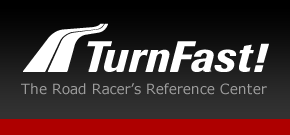Article Topics:
- Overview
- Intro to Racing
- Driving Technique
- Practice Sessions
- Driver’s Gear
- Vehicle Safety
- Handling
- Brakes
- Power
- Tools
TurnFast
recommends
these books:
Articles about Handling
- Chassis Braces
- Wheel Alignment
- Tuning Guide
Chassis Braces
Even though it is made of steel (and whatever else), the chassis and body of every car flexes. As a car progresses through a turn, the forces involved will cause the car to twist. This needs to be minimized.
This twisting is not the slanting of body roll as the springs stretch on one side and compress on the other. This is an actual twisting of the floor pan and body panels. Like the flexing of a suspension system, this twisting impacts the tire contact patches, and in fact affects the suspension system by changing the suspension system's alignment with the body and with the road surface.
The most common after market street modification to reduce twisting is to add shock tower braces. The car's body structure by necessity has several very large cutouts to accommodate doors and windows, the engine hood, and the trunk or hatchback door. These holes, like large holes cut out of a box, reduce the strength of the body and make it easier for the car to twist.
Shock tower bars add a solid bar across the tops of the shock towers (they just happen to be a convenient point that can be connected with a straight or nearly straight bar) to fill the gaps in two of the largest holes--across the engine bay and across the trunk cavity. During cornering these bars add strength and reduce the overall twisting of the body.
Aftermarket tower braces are typically fairly easy bolt-in items. In addition to installing these, shops which specialize in modifying your particular car may also know of unique weak spots in the car's chassis that benefit from special bracing as well.
Is one bar style or make going to be functionally better than another. Probably, but overall they're all going to be very close, and likely beyond your ability to tell the difference. Some cars are going to accommodate bars which go directly from one tower to the other. Other cars may not have space in the engine bay to do this, and may instead connect the shock towers to the firewall. Likewise, some cars will have room for rear tower bars, and others will not.
The next stage in stiffening the chassis is usually adding a roll cage. Though primarily a safety feature, roll cages are welded or bolted to the chassis in several places which adds to the chassis' resistance to twisting.
There are numerous styles of roll bars and roll cages. The difference between a roll bar and cage is the complexity of the structure, and its scope of protection. Generally, the roll bar's purpose is only to provide a crush resistant structure above the driver's head. This is usually a single bar with support bars to have four points of contact with the car chassis for strength (a two-point roll bar is useless for racing).
A roll cage is a more complete structure designed to protect the driver from all sides. Obviously, the latter is safer, but may be impractical for the dual purpose street car as it will require significant modification to the car's interior panels.
For time trial driving or autocrossing, the four point roll bar adds a significant level of rollover safety without sacrificing the interior of the car much. It will render the back seat unusable for passengers however. Even if passengers fit, the proximity of the steel bars designed for front passenger safety, makes for a very dangerous environment for rear passengers.
Read Next Article (Tuning Guide)

